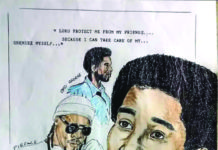by Randall Sondai Ellis
Written Oct. 2, 2011 – I want to thank everyone for all the warm support they’ve shown in these crucial moments. The support we feel from the people has forever changed me. To witness people in the world stand up and say no to state-sanctioned torture is overwhelming and a beautiful sight indeed. Thank you all!
 On Sept. 27, 2011, the state took the first steps at trying to break the hunger strike [which had resumed the previous day, on Sept. 26, after the first round in July]. At around 9 a.m. they called a number of individuals – whom they considered to be involved in some way or another with the negotiations surrounding the strike – telling them that a state senator sent the inspector general to meet with them to see what’s going on up here.
On Sept. 27, 2011, the state took the first steps at trying to break the hunger strike [which had resumed the previous day, on Sept. 26, after the first round in July]. At around 9 a.m. they called a number of individuals – whom they considered to be involved in some way or another with the negotiations surrounding the strike – telling them that a state senator sent the inspector general to meet with them to see what’s going on up here.
Well, these men never returned from this supposed meeting with the inspector general and instead were moved to the ASU (Administrative Segregation Unit) building to isolate them from the rest of us. About six or eight men were moved from D2 to the ASU building. I do not know how many were moved from the other buildings, but they were moved from there as well. Their personal property and other belongings were confiscated and put in storage.
Only you, the public can demand to know what kind of conditions these men are being forced to endure inside the freezing cold ASU building. One is not even permitted to keep their shoes inside their cells. The strike will not end until these men are returned. [See “Hunger strike organizer: Ad-Seg/ASU units are bad news” by Todd Ashker and “They took the 15 of us hunger strikers to ASU-Hell-Row” by Mutope Duguma (James Crawford) for reports from two of the men taken to the Pelican Bay ASU.]
Only you, the public can demand to know what kind of conditions these men are being forced to endure inside the freezing cold ASU building.
On Sept. 29 at 7 p.m., prison officials conducted a search of D2 and confiscated all food items, canteen, coffee, kool-aid, all food items from every cell – even from those who were not participating in the hunger strike – in typical group punishment fashion.
 On Oct. 1, all visits for those on hunger strike were cancelled.
On Oct. 1, all visits for those on hunger strike were cancelled.
It’s important to understand that we are at this critical moment in history because the judicial system has failed to act and have made numerous excuses disguised as legal opinion to overlook blatant constitutional abuses.
When the 4th Circuit first came down with its ruling dealing with the segregation of suspected gang affiliates in Toussaint v. McCarthy, 801 F.2d 1080, 1101 (9th Cir. 1986), the court said because the segregation of suspected gang affiliates was not a disciplinary measure, prisoners were only entitled to minimal due process protections when they are placed in segregation for suspected gang involvement.
The court said because the segregation of suspected gang affiliates was not a disciplinary measure, prisoners were only entitled to minimal due process protections when they are placed in segregation for suspected gang involvement.
This meant that anyone suspected and/or accused of so-called gang activity is entitled to only the most minimal due process protections, these being 1) notices, some notice of what you’re suspected of; courts have ruled that this notice doesn’t need to be detailed and 2) an opportunity to express your views to the gang investigator about his decision.
 This meant that prison officials did not have to prove anything, anything at all, about your suspected gang involvement. All they had to do was write a sensational report about the so-called gang, fit you into the story and, boom, you’re done unless, of course, you’re willing to snitch and compound those lies with sensational lies of your own.
This meant that prison officials did not have to prove anything, anything at all, about your suspected gang involvement. All they had to do was write a sensational report about the so-called gang, fit you into the story and, boom, you’re done unless, of course, you’re willing to snitch and compound those lies with sensational lies of your own.
Over the years prisoners subjected to the whimsical accusations of the gang investigators and their informants have attempted to bring about some sort of constitutional protections to such broad arbitrary authority, only to fall short in the face of a judiciary afraid to act and place some kind of constitutional protection against these wild, frenzied accusations that cannot be proven against the individuals to whom they are leveled.
Again the 9th Circuit addressed the subject in Bruce v. Elfist, 351 F.3rd 1283, 1287 (9th C.R. 2003), again stating that the segregation of gang members is not a disciplinary measure and therefore all that is required is “some evidence” to support the administrative decision. Again the court refused to place any protections at all (beyond the minimum) on this unbridled authority to accuse without proof by simply requiring that the administrative decision contain “some evidence” which of course is the word of the administrator.
 The court in Toussiant did require that prisoners placed in segregation must be reviewed every 120 days – now 180 – for consideration for release and those reviews must amount to more than meaningless gestures. Again courts have refused to enforce this footnote when prisoners began showing how their 180 day reviews were in fact meaningless gestures. They had become nothing more than a session where the prisoner is asked, “Would you like to debrief?” The committee elects to retain the prisoner in SHU based on his membership or association with a prison gang who’s involved in criminal conspiracies against others.
The court in Toussiant did require that prisoners placed in segregation must be reviewed every 120 days – now 180 – for consideration for release and those reviews must amount to more than meaningless gestures. Again courts have refused to enforce this footnote when prisoners began showing how their 180 day reviews were in fact meaningless gestures. They had become nothing more than a session where the prisoner is asked, “Would you like to debrief?” The committee elects to retain the prisoner in SHU based on his membership or association with a prison gang who’s involved in criminal conspiracies against others.
The 9th Circuit briefly addressed the issue of debriefing in Castro v. Toebune, 29 Fed. Appx. 463 (9th Cir. 2002), saying the debriefing process, by which prisoners leave the prison’s Security Housing Unit (SHU) and during which prisoners are given opportunity to receive more lenient treatment from prison officials in exchange for information concerning gang activity in prison, did not violate the inmate’s privilege against self-incrimination where inmates were not compelled to debrief. Obviously the court does not consider conditions that amount to torture inflicted for the sole purpose of forcing one to debrief to be a compelling act. Justice truly is blind.
The 9th Circuit said the debriefing process did not violate the inmate’s privilege against self-incrimination where inmates were not compelled to debrief. Obviously the court does not consider conditions that amount to torture inflicted for the sole purpose of forcing one to debrief to be a compelling act.
It boils down to the court’s continued failure to act and its continued insistence on twisting logic to justify draconian policies and practices. The so-called Castillo settlement, we were told, was going to improve the process and afford us more protection against arbitrary state action under the guise of so-called gang activity. Well, that turned out to be the same old window-dressing, hidden with codes and tricks.
 The first thing it did was abolish the 180-day review requirement for consideration of release to a so-called inactive review every six years. We’ve found that the review is arbitrary and is really a slick method used to temper indefinite confinement. For example, instead of saying the prisoner was validated in 1976, they now say the prisoner was validated in 1976 as a gang member and re-validated in 2004, again in 2010 etc.
The first thing it did was abolish the 180-day review requirement for consideration of release to a so-called inactive review every six years. We’ve found that the review is arbitrary and is really a slick method used to temper indefinite confinement. For example, instead of saying the prisoner was validated in 1976, they now say the prisoner was validated in 1976 as a gang member and re-validated in 2004, again in 2010 etc.
Therefore each inactive review constitutes a re-validation, requiring only the whim of the gang investigator to determine one’s fate. A prisoner is not allowed to refuse an inactive review. The IGI shows up at your cell saying cell search, cuff up, when they walk you down to a holding cage. They will then tell you this is your inactive review and proceed to removing all your property from your cell. They have already determined your fate; this is just an exercise in brute state authority.
If your cell doesn’t turn up a newspaper or a book that belongs to another prisoner, they will recycle something – such as saying your name was discovered on a roster in another prisoner’s cell. Anything can be and is considered gang activity. The Castillo settlement only required that the IGI now write their nonsensical reasons down on paper and give the prisoner a copy. That’s all.
Anything can be and is considered gang activity.
I’ve personally witnessed this sham. In 2000 I was transferred to Corcoran SHU for the lack of documentation for gang participation after a so-called inactive review. Obviously their goal was to manufacture documentation of gang participation in Corcoran SHU and tell state controlled media outlets that Pelican Bay has begun releasing prisoners under the new inactive program.
 What many prisoners were never told is the settlement contains a clause that forbids a court from granting any prisoner relief for a violation of any of its terms. The courts in a series of unpublished decisions held the Castillo settlement to have corrected unconstitutional practices, but it didn’t establish any additional rights at all. So again the courts played the old bait and switch.
What many prisoners were never told is the settlement contains a clause that forbids a court from granting any prisoner relief for a violation of any of its terms. The courts in a series of unpublished decisions held the Castillo settlement to have corrected unconstitutional practices, but it didn’t establish any additional rights at all. So again the courts played the old bait and switch.
The Castillo settlement contains a clause that forbids a court from granting any prisoner relief for a violation of any of its terms.
The Supreme Court ruled in Hewitt v. Helms, 459 U.S. 460 (1963), that solitary confinement cannot be used as a pretext for indefinite confinement. However, these words have no meaning at all, especially since they were overruled in Sandin v. Connor, 515 U.S. 472, 477-75 (1995), finding that to even have any due process protections at all, state action must impose an artificial and significant hardship on the prisoner within the ordinary incidents of prison life.
The District Court in Madrid v. Gomez, 889 F.Supp. 1155 (N.D.Cal. 1995), recognized the conditions in the SHU exposed a prisoner to an artificial and significant hardship but stopped short of taking any action beyond the minimum to address it. Instead, the court said more torture could mean more time is needed to see just how such confinement would affect the prisoner. Some comfort to all the men who have died thus far from state-sanctioned torture!
The court said more torture could mean more time is needed to see just how such confinement would affect the prisoner. Some comfort to all the men who have died thus far from state-sanctioned torture!
In Wilkinson v. Austin, 545 U.S. 209, 223-25 (2005), the Supreme Court threw prisoners yet another rebuke when it endorsed the concept of limited due process addressing a claim brought by the prisoners of the Ohio supermax facility. The court said since prisoners’ placement in the Ohio supermax renders them ineligible for parole, some due process must be provided before they are placed there. Some due process simply means the minimum process allowed.
 For decades – me personally for 28 years – we have sat here and watched this process develop into an arrogant and abusive monstrosity, when it was first publicly proclaimed that the only way to leave the SHU is by debriefing, paroling or dying. It should have been a clear indication that prisoners confined to the SHU indefinitely were in fact in punitive segregation.
For decades – me personally for 28 years – we have sat here and watched this process develop into an arrogant and abusive monstrosity, when it was first publicly proclaimed that the only way to leave the SHU is by debriefing, paroling or dying. It should have been a clear indication that prisoners confined to the SHU indefinitely were in fact in punitive segregation.
When the state legislature passed SB 16X taking good time credits away from anyone housed in the SHU for disciplinary reasons, with a footnote that added “or upon validation as a gang member or associate,” it should have been a clear indication that prisoners housed in the SHU indefinitely are in fact in punitive segregation without having been found guilty of breaking one single rule.
Prisoners housed in the SHU indefinitely are in fact in punitive segregation without having been found guilty of breaking one single rule.
As luck would have it, the 9th Circuit has also addressed this issue in Munoz v. Rowland, 104 F.3d 1096 (9th Cir. 1997), stating the fact that a non-disciplinary finding about Munoz’s gang affiliations may one day influence a purely administrative classification decision should he someday return to prison is far too “ephemeral to constitute collateral consequence for mootness purposes.” Again the court chose to be blind to the core facts of punishment being doled for non-disciplinary reasons. Essentially it’s an accusation that because we think you’re a gang member we think you might do something wrong, so here’s your punishment.
 However, the court in Munoz, did say that associating with gang members is not standing alone a crime even outside of prison. Now ain’t that something? The court seemed to recognize that to be guilty of a crime, it requires more than mere association.
However, the court in Munoz, did say that associating with gang members is not standing alone a crime even outside of prison. Now ain’t that something? The court seemed to recognize that to be guilty of a crime, it requires more than mere association.
Yet on the other hand, they openly allow an entire class of people to be subjected to torturous conditions admittedly to extract information and then refuse to call it punishment. In fact a federal judge boldly has said that validated prisoners are serving life without parole as long as they are housed in the SHU, contributing to the abuse that has brought us to this moment.
They openly allow an entire class of people to be subjected to torturous conditions admittedly to extract information and then refuse to call it punishment.
In Beard v. Banks, 548 U.S. 521 (2006), the Supreme Court said courts must accord substantial deference to the judgment of prison officials. This even goes beyond just deference. Now they are entitled to double deference.
 Prison officials are stuck in a mindset that began in the 1940s-1960s when the first case ever decided in California was filed, entitled Jordan v. Fitzharris. In an unprecedented move, the federal court in San Francisco decided to hear the case. It would be the first time a federal tribunal would investigate state prison conditions.
Prison officials are stuck in a mindset that began in the 1940s-1960s when the first case ever decided in California was filed, entitled Jordan v. Fitzharris. In an unprecedented move, the federal court in San Francisco decided to hear the case. It would be the first time a federal tribunal would investigate state prison conditions.
The case went to trial on Aug. 9, 1966, before U.S. District Court Chief Judge George B. Harris, who found “conditions of a shocking debased nature.” And the song and dance began to sweep and reform cruel constitutional abuses under the rug for all time.
The fomenting of gang violence – the pitting the races against each other as a means of keeping control – is the only methodology they know and have ballooned into a billion dollar industry. At a time when other states are being forced to slash budgets and cut spending, California has been quietly building four new prisons. The majority of the stimulus money sent to California was used to pay correctional guards without one word of an outcry.
The fomenting of gang violence – the pitting the races against each other as a means of keeping control – is the only methodology they know and have ballooned into a billion dollar industry.
Prisoners have become cogs caught in the grip of an ever widening prison industrial complex – the subjects of pensions and budgets. No wonder any changes will have to be approved by the stakeholders. At a hearing held in the Del Norte County Superior Court in 2002 relative to the confiscation of mail, the state’s gang expert – who, by the way, is Correctional Counselor Specialist II D. Hanks – had the following exchange:
A: A terrorist group is a group that has been identified as accomplishing their means through acts of terrorism, such as bombs, as murder, weapons manufacturing and dissemination, looking to attack individuals and groups based on their nationality.
Q. So what you’re talking about is terrorism groups that would fit the definition of Penal Code 186.22?
A: That’s part of it. That’s part of what’s identified as street terrorism, for which individuals could be prosecuted and given enhancements to their sentences.
Q: That’s a gang enhancement, isn’t it?
A: That’s what’s known as a gang enhancement, but it’s also identified as street terrorism.
Q: So it’s a fancy name to talk about street terrorism – gangs – gangs and street terrorism can be the same thing?
A: They could be.
Q: Is gang as defined under 186.22 and street terrorism groups synonymous?
A: They can be synonymous, yes.
 Q: Okay. When aren’t they synonymous? Let me rephrase that. What gang that would fit the definition of 186.22 would not be a street gang or a street terrorism group?
Q: Okay. When aren’t they synonymous? Let me rephrase that. What gang that would fit the definition of 186.22 would not be a street gang or a street terrorism group?
A: Well, an individual can be identified under 186.22, prosecuted or receive a gang enhancement under that for participation in a gang without necessarily contributing personally to an act of terrorism.
Q: Well, acts of terrorism – let me stop you there. Aren’t you talking about a gang event? Isn’t that what’s defined under 186.22, a gang-assisted event?
A: Yes.
Q: OK, and you’re saying that that also is an act of terrorism, street terrorism?
A: Prison gangs fall under 186.22 as well.
This is actual testimony from their correctional specialist and in their minds they are trying to work towards the development of a model to condition the public to the belief that they are dealing with a bunch of terrorists using the euphemism of gang. With a validation protected by only minimal due process protecting but carrying such enormous collateral consequences and in the face of court ruling after court ruling refusing to recognize these consequences, prisoners have come together to shout, Enough!
They are trying to work towards the development of a model to condition the public to the belief that they are dealing with a bunch of terrorists using the euphemism of gang.
George Jackson reminded us over 40 years ago to “(s)ettle your quarrels, come together, understand the reality of our situation, understand that fascism is already here, that people are already dying who could be saved, that generations more will die or live poor butchered half-lives if you fail to act.” It certainly is refreshing to see prisoners finally heeding that advice, as we have certainly pushed ourselves into a corner mindlessly being pawns in their game.
 Power concedes nothing without a demand. The five core demands of the hunger strikers are simple, reasonable, just and dynamic: 1) End group punishment and administrative abuse, 2) abolish the debriefing policy and modify the active/inactive review criteria, 3) comply with the recommendations regarding long-term solitary confinement, 4) provide adequate and nutritious food, 5) expand programming, correspondence courses and other privileges for indefinite SHU housing status prisoners.
Power concedes nothing without a demand. The five core demands of the hunger strikers are simple, reasonable, just and dynamic: 1) End group punishment and administrative abuse, 2) abolish the debriefing policy and modify the active/inactive review criteria, 3) comply with the recommendations regarding long-term solitary confinement, 4) provide adequate and nutritious food, 5) expand programming, correspondence courses and other privileges for indefinite SHU housing status prisoners.
Now the CDCR proclaims to be willing to make changes to its gang management policies. Those changes thus far seem to be the same old bag of tricks. They’re proposing now to come take all our property and evaluate us every six months to give us something back – in other words, to make us jump through a hoop where the hoop keeps moving until you eventually jump off a cliff.
They are proposing to recycle these same old allegations and require the segregated gang affiliate to sign the form admitting these allegations, and should one refuse to sign, that too is deemed to be an admission to membership and one’s refusal to debrief.
The CDCR should have to prove its accusations of gang activity, membership or association, providing the full panoply of constitutional protections. This is the only way to put an end to this frenzied, unbridled gung ho mindset that has developed unchecked for decades.
The CDCR should have to prove its accusations of gang activity, membership or association, providing the full panoply of constitutional protections.
Now the record is clear and the arbitrariness is adequately documented. If the courts will not discharge their duty to protect constitutional rights, then the people must demand a change as is our/your right. Please keep the men just moved to the ASU in your thoughts and prayers and demand that they’re treated justly and humanely in their courageous efforts to end state-sanctioned torture – because no doubt their torture has been taken up a notch.
Randall Sondai Ellis is a prisoner at Pelican Bay who’s been in the SHU for the last 28 years for allegedly associating with gang members and refusing to debrief. He has been in prison for the last 30 years since the young age of 16. He can be reached at Randall Ellis, C-68764, SHU D2-213, P.O. Box 7500, Crescent City, CA 95532-7500. Send our brother some love and some light.

 Store
Store









